

Bella Smith
OPN1LW Membrane Protein Introduction. "Creative Biolabs is committed to providing highly customized comprehensive solutions with the best quality to advance our global clients’ projects.
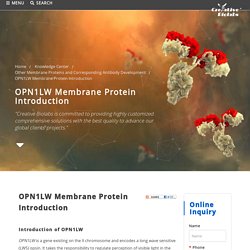
" OPN1LW Membrane Protein Introduction Introduction of OPN1LW OPN1LW is a gene existing on the X chromosome and encodes a long wave sensitive (LWS) opsin. It takes the responsibility to regulate perception of visible light in the yellow-green range on the visible spectrum (around 500-570nm). The gene contains 6 exons with variability that induces shifts in the spectral range. CD81 Membrane Protein Introduction. "Creative Biolabs is committed to providing highly customized comprehensive solutions with the best quality to advance our global clients’ projects.
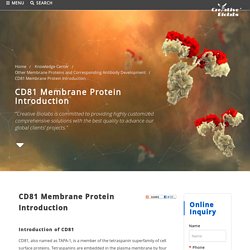
" CD81 Membrane Protein Introduction Introduction of CD81 CD81, also named as TAPA-1, is a member of the tetraspanin superfamily of cell surface proteins. Tetraspanins are embedded in the plasma membrane by four transmembrane domains that flank short amino and carboxyl cytoplasmic termini and a small and a large extracellular loop. CD81 is composed of a stalk of two longer α helices and a novel mushroom-like head structure folded with the help of two disulfide bridges. APP Membrane Protein Introduction. "Creative Biolabs is committed to providing highly customized comprehensive solutions with the best quality to advance our global clients’ projects.
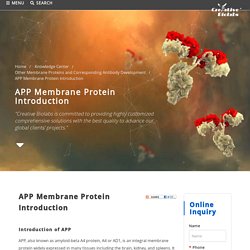
" APP Membrane Protein Introduction Introduction of APP APP, also known as amyloid-beta A4 protein, A4 or AD1, is an integral membrane protein widely expressed in many tissues including the brain, kidney, and spleens. It is known as the precursor protein which undergoes extensive post-translational modification including glycosylation, sialylation, phosphorylation, and tyrosine sulfation, as well as a number of types of proteolytic processing to form peptide fragments. The amyloid beta involved in the pathological process of Alzheimer's disease (AD) is formed through sequential cleavage of the APP. VTI1B Membrane Protein Introduction.
"Creative Biolabs is committed to providing highly customized comprehensive solutions with the best quality to advance our global clients’ projects.

" VTI1B Membrane Protein Introduction Introduction of VTI1B SNAREs are membrane-anchored proteins that usually contain a C-terminal transmembrane domain, an adjacent SNARE motif, and an N-terminal domain. They are key regulators in all fusion events. Before fusion, the SNARE motifs assemble into a four-helix bundle. Voltage-dependent Calcium Channel Proteins Family. "Creative Biolabs is committed to providing highly customized comprehensive solutions with the best quality to advance our global clients’ projects.
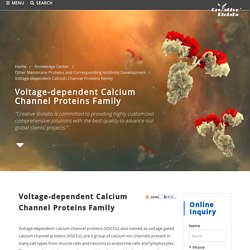
" Voltage-dependent Calcium Channel Proteins Family Voltage-dependent calcium channel proteins (VDCCs), also named as voltage-gated calcium channel proteins (VGCCs), are a group of calcium ion channels present in many cell types from muscle cells and neurons to endocrine cells and lymphocytes. They are multimeric transmembrane proteins that consist of a main pore-forming or α1 subunit and auxiliary subunits, α2δ, and β subunits. And α1 subunit plays a key role in maintaining the normal channel functions. VDCCs mediate the influx of calcium ions into excitable and nonexcitable cells in response to membrane potential changes. Synaptic Vesicle Glycoprotein. "Creative Biolabs is committed to providing highly customized comprehensive solutions with the best quality to advance our global clients’ projects.
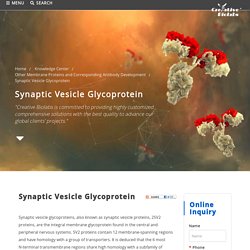
" Synaptic Vesicle Glycoprotein Synaptic vesicle glycoproteins, also known as synaptic vesicle proteins, 2SV2 proteins, are the integral membrane glycoprotein found in the central and peripheral nervous systems. SV2 proteins contain 12 membrane-spanning regions and have homology with a group of transporters. It is deduced that the 6 most N-terminal transmembrane regions share high homology with a subfamily of transporters such as the human glucose transporter, while the 6 most C-terminal regions are identified with the plasma membrane transporters for neurotransmitters.
Studies have been identified that SV2 proteins mediate the fast Ca2+-dependent synaptic vesicle exocytosis participating in the regulation of neurotransmitters transmission. Large Neutral Amino Acids Transporter Family. "Creative Biolabs is committed to providing highly customized comprehensive solutions with the best quality to advance our global clients’ projects.
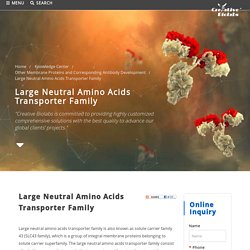
" Large Neutral Amino Acids Transporter Family Large neutral amino acids transporter family is also known as solute carrier family 43 (SLC43 family), which is a group of integral membrane proteins belonging to solute carrier superfamily. The large neutral amino acids transporter family consist of only three genes that encode the transporters with system L amino acid transporter activity including LAT3 (SLC43A1), LAT4 (SLC43A2), and the orphan protein EEG1 (SLC43A3). SLC43A1 and SLC43A2 contain 12 putative transmembrane domains with both N and C termini located intracellularly.
They are the Na+ and Cl- -independent neutral amino acid transporters with two kinetic components. Here shows part of the SLC43 family in humans including SLC43A1 and SLC43A2, encoded by SLC43A1 and SLC43A2 genes, respectively. Solute Carrier Family 25. "Creative Biolabs is committed to providing highly customized comprehensive solutions with the best quality to advance our global clients’ projects.
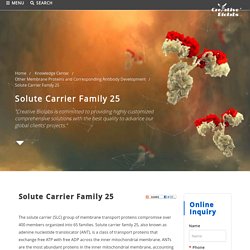
" Solute Carrier Family 25 The solute carrier (SLC) group of membrane transport proteins compromise over 400 members organized into 65 families. Solute carrier family 25, also known as adenine nucleotide translocator (ANT), is a class of transport proteins that exchange free ATP with free ADP across the inner mitochondrial membrane. ANTs are the most abundant proteins in the inner mitochondrial membrane, accounting for up to 10% of total mitochondrial protein content. ANTs play a central role in the transport of metabolites and cofactors across the mitochondrial inner membrane. ANTs have two subunits which are located in the inner mitochondrial membrane and contribute to the exchange of mitochondrial ATP and cytosolic ADP.
Solute Carrier Family 18. "Creative Biolabs is committed to providing highly customized comprehensive solutions with the best quality to advance our global clients’ projects.
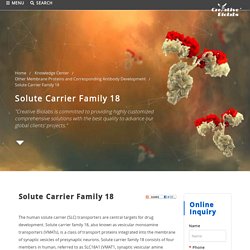
" Solute Carrier Family 18 The human solute carrier (SLC) transporters are central targets for drug development. Solute carrier family 18, also known as vesicular monoamine transporters (VMATs), is a class of transport proteins integrated into the membrane of synaptic vesicles of presynaptic neurons. Solute carrier family 18 consists of four members in human, referred to as SLC18A1 (VMAT1, synaptic vesicular amine transporter), SLC18A2 (VMAT2, synaptic vesicular amine transporter), SLC18A3 (vesicular acetylcholine transporter, VAChT), SLC18B1 (MFS-type transporter SLC18B1).
They function to transport monoamine neurotransmitters including dopamine, norepinephrine, serotonin, epinephrine, and histamine into the vesicles which release the neurotransmitters into synapses as chemical messages to postsynaptic neurons. Ryanodine Receptor Family. "Creative Biolabs is committed to providing highly customized comprehensive solutions with the best quality to advance our global clients’ projects.
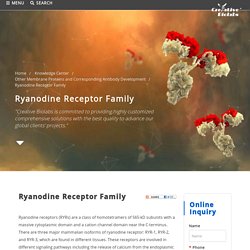
" Ryanodine Receptor Family Ryanodine receptors (RYRs) are a class of homotetramers of 565-kD subunits with a massive cytoplasmic domain and a cation channel domain near the C-terminus. There are three major mammalian isoforms of ryanodine receptor: RYR-1, RYR-2, and RYR-3, which are found in different tissues. These receptors are involved in different signaling pathways including the release of calcium from the endoplasmic and sarcoplasmic reticulum into the cytosol ryanodine receptors, converting different extracellular stimuli into intracellular calcium signals. RYRs form a group of intracellular calcium channels in various forms of excitable animal tissue such as neurons, muscle cells, and epithelial cells.
Antibodies Types Formats Creative Biolabs. Antigen Products for Vaccine Development. CAR T Cell Based Immunotherapy Basic Principles.
PreciAb. Antibody from Cretaive Biolabs. BsAbs from Creative Biolabs. Vaccines from Creative Biolabs. CAR T Therapy. Antibody-drug Conjugate.